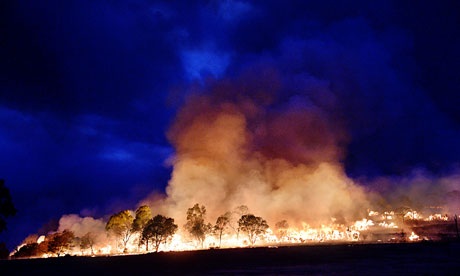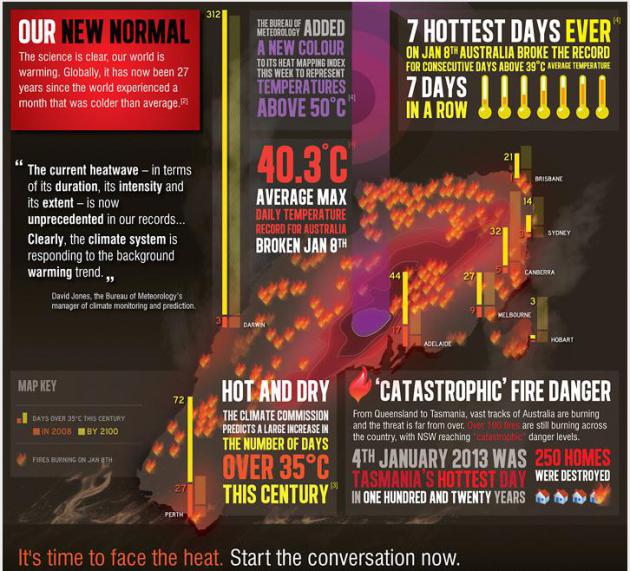Global temperatures are almost half a degree Celsius above the long-term average so far in 2013, putting this year on course to be among the 10 hottest since records began, the world's leading meteorological agency says.
In a provisional statement on the global climate in 2013, the World Meteorological Organisation says the first nine months of this year tied with 2003 as the seventh hottest such period on record.
The statement was released in Warsaw on Wednesday where countries are meeting for the latest round of negotiations on a new treaty to tackle global warming.
In Australia, temperatures are on track for the hottest year on record. Australia's temperatures from January to October were 1.32 degrees above average, which annually is 21.8 degrees. The same period was 0.24 degrees above the next highest record - which occurred in 2005 - for January to October temperatures.
Advertisement
Dr Blair Trewin, senior climatologist at Australia's Bureau of Meteorology said it would take significantly below-average temperatures in November and December for a record hot year not to occur across the nation.
The meteorological organisation's secretary-general, Michel Jarraud, said all the warmest years across the planet had occurred since 1998, and 2013 once again continued the underlying long-term trend of warming.
''The coldest years now are warmer than the hottest years before 1998,'' he said. ''Atmospheric concentrations of carbon dioxide and other greenhouse gases reached new highs in 2012, and we expect them to reach unprecedented levels yet again in 2013. This means that we are committed to a warmer future.''
Global land and ocean temperatures are recorded by the organisation as about 0.48 degrees higher in January to September than the 1961-1990 average. The temperatures so far this year are the same as the average for 2001-10, the warmest decade on record.
In other areas the extent of Arctic sea ice recovered slightly from record rates of melting last year, but 2013 was still one of the lowest years on record. Conversely in Antarctica, sea ice extent reached a record high in September. The organisation says Antarctica differs from the Arctic because it is land surrounded by open water, whereas the Arctic is comprised of water surrounded by land.
Tropical cyclones numbers for 2013 are nearing the 1981-2010 average of 89 storms, with 86 so far this year.
***
Australian heatwaves 'five times more likely due to global warming'
Human activities will account for at least half of extreme summer temperatures likely to hit Australia in the future, say scientists

Bushfires at Grampians national park, Victoria, Australia. Extreme weather can lead to more severe and frequent disasters. Photograph: Jason Edwards/Newspix / Rex Feat
Global warming has increased five-fold the probabilities that Australians will bake in record hot summers, according to new research from the University of Melbourne.
And human activities - including greenhouse gas releases from fossil fuels - must account for at least half of these extreme summer temperatures of the future, the scientists say.
Sophie Lewis and David Karoly report in Geophysical Research Letters, a journal of the American Geophysical Union, that they used climate observations and more than 90 climate model simulations to deliver their verdict, and to highlight the unexpected nature of the events of the first months of 2013, the hottest in the country's observational record.
Australians are used to summer heat, drought and periodic bush fires as part of the continent's natural cycle, and these are often linked to a Pacific Ocean temperature phenomenon known as El Niño, dubbed "the Child" in Peru because it tends to occur around Christmas time.
But there was no El Niño: if anything, the ocean heat was turned down a little in a counter phenomenon called La Niña. So the extreme heat, catastrophic flooding and devastating bushfires early this year - the southern hemisphere summer - were certainly not expected.
"This extreme summer is not only remarkable for its record-breaking nature but also because it occurred at a time of a weak La Niña to neutral conditions, which generally produce cooler summers", said David Karoly. "Importantly our research shows the natural variability of El Niño-Southern Oscillation is unlikely to explain the recent record temperatures."
Sophie Lewis, who is also at the Australian Research Council's Centre of Excellence for Climate System Science, warned that such extreme summers will become even more frequent and more severe in the future, as the planet warms further.
Between December 2012 and February 2013, Australians experienced the hottest month in the nation's recorded history, and the hottest day. There were fierce and destructive bush fires in Tasmania and Victoria, and severe flooding in New South Wales and Queensland. The Australian media dubbed it "the angry summer".
"We cannot categorically ascribe the cause of a particular climate event to anthropogenic climate change; however, the roles of various factors contributing to the change in odds of an event occurring can be identified", the two scientists write.
They examined the historical record of more than 150 years of observation, and found, repeatedly, that extreme summers tended to occur in step with El Niño years: in fact were three times more likely to happen in an El Niño year than a La Niña season.
Clearly, something else was at work in the summer of 2013. Natural climatic variations were not likely to have caused the bush fires and the floods. It was possible to say, with more than 90% confidence, that human influences on the Australian atmosphere had dramatically increased the odds of extreme temperatures.
By the end of the century, other studies have shown, 65% of all summers are likely to be "extremely hot". There was also research that suggested longer summers - that is, shorter springs and autumns - might be expected as carbon dioxide levels continued to rise. In those parts of Australia that were both heavily populated, and at risk of bush fire, humans would have to adapt.

No comments:
Post a Comment